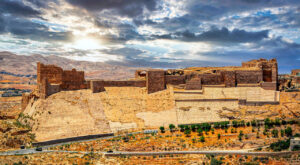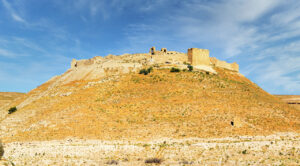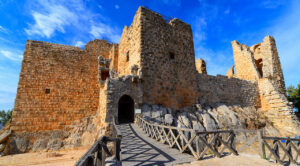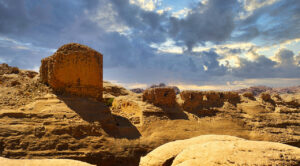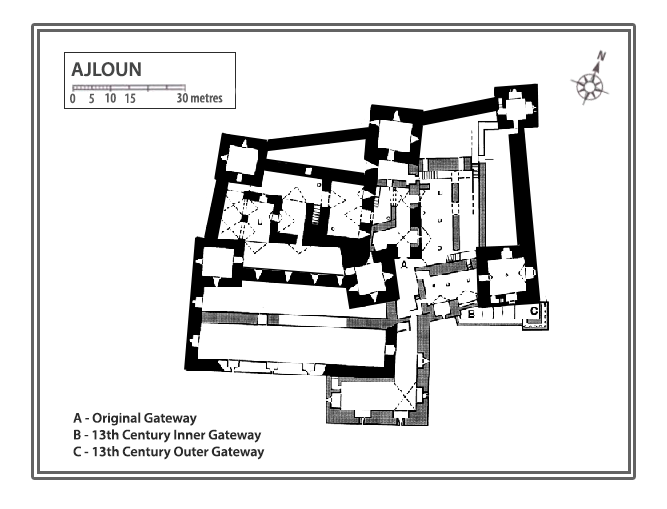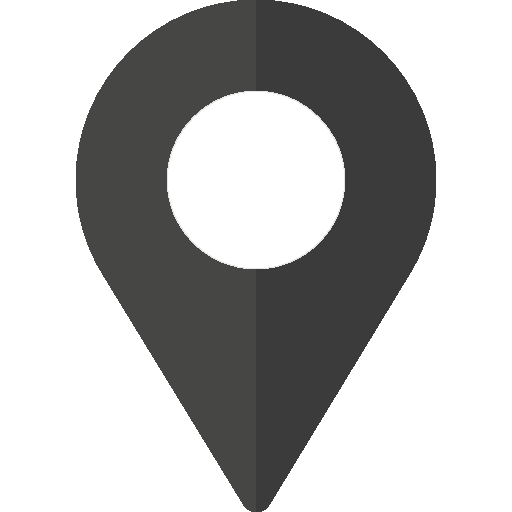Set atop a commanding hill in northern Jordan, Ajloun Castle, also known as Qalʻat ar-Rabad, is a remarkable example of Islamic military architecture. Located only 25 km from Jerash, this historic fortress weaves together centuries of history, strategic ingenuity, and architectural mastery. Originally constructed between 1184 and 1188 by Izz ad-Din Usama bin Munqidh, the nephew of Saladin, and later modified by the Mamluks, the castle served as a critical fortification against Crusader forces.
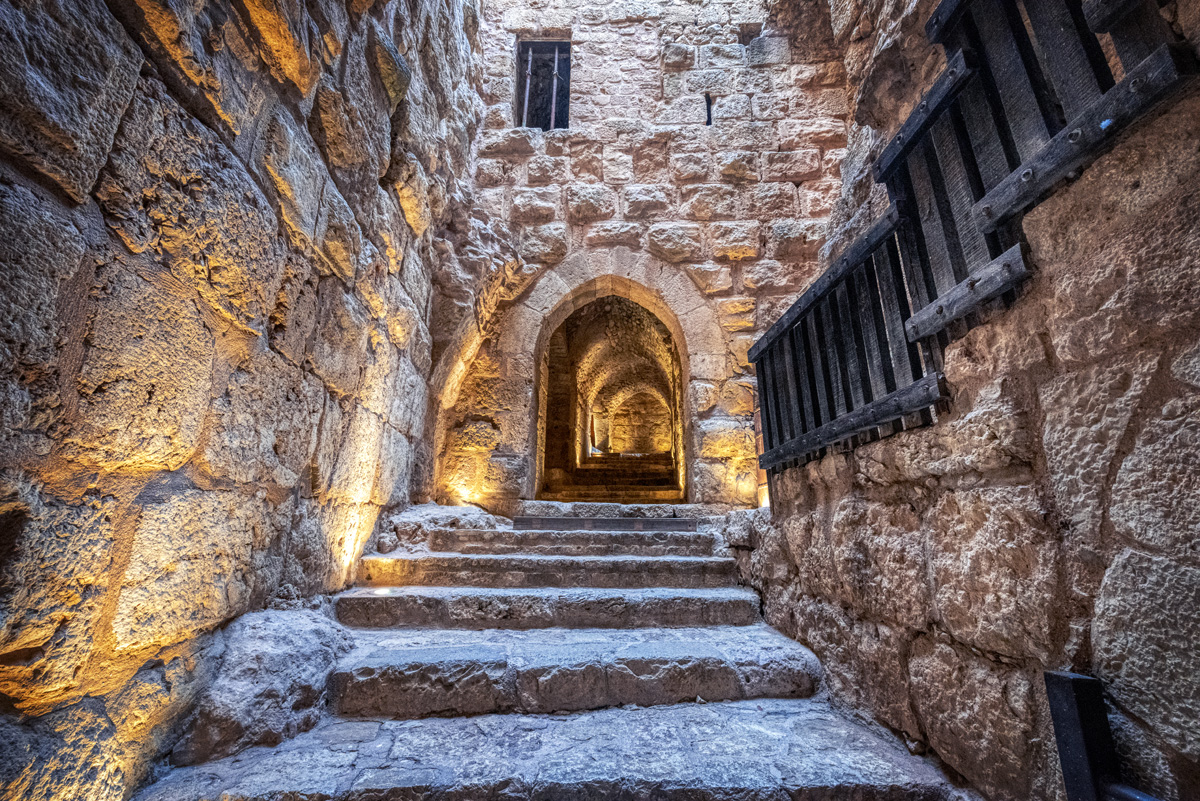
The Towers and Defensive Design
The castle boasts seven impressive towers crafted from limestone quarried from the surrounding moat. Four of these were part of the initial design, while others, such as the formidable L-shaped Tower of Aybak on the southeast corner, were added later to fortify its defences. Each tower served an essential function. For instance, the three-level Tower of Aybak housed a soldier’s quarters on the lower floor, a mosque on the middle level with intricately carved stone details, and a palace on the uppermost floor.
The castle’s architecture includes an ingenious roofing system of barrel and cross vaults, creating grand, light-filled spaces that enhance both protection and aesthetic delight. Some areas were deliberately left unroofed, allowing sunlight to illuminate its interiors and enhance the atmosphere of this medieval stronghold.
The Church and Monastic Origins
On the upper levels—the oldest section of the castle—lie the remnants of a small Byzantine church, a vivid reminder of the site’s pre-Islamic past. The remains showcase features such as a nave, presbytery, and a partially intact mosaic floor portraying loaves of bread and fish, accompanied by a Greek inscription honouring Deacon Aryano. These artefacts provide compelling evidence that the castle was constructed upon the ruins of an ancient monastery, demonstrating the site’s enduring significance across eras and cultures.
An Intriguing Settlement Hub
Ajloun Castle became the heart of a settlement that flourished into the present-day town of Ajloun. Its nickname, “The Castle with the Suburbs,” reflects its role as a nucleus of community life during its peak years of use.
Before stepping into the castle’s history-laden corridors, visitors can stop by the adjacent visitor centre, which offers convenient amenities such as a ticket office, ample parking, a small souvenir shop, and modern toilets known to be among the cleanest facilities in Jordan. Occasionally, knowledgeable local guides are available to provide multilingual tours, enriching the experience with stories of the castle’s history and design. Alternatively, the plentiful information boards in English and Arabic offer detailed explanations for self-guided exploration.
Inside the castle, you’ll also discover a small museum near the main gate, showcasing artifacts like ancient pots and everyday items that once belonged to inhabitants of this region. This thoughtfully curated collection adds a tangible layer to the story of Ajloun and its historical significance.
Ajloun Castle represents centuries of cultural and military ingenuity, seamlessly blending Islamic design with the traces of its Byzantine foundation. Whether you’re admiring the awe-inspiring towers, stepping into the echoes of the ancient church, or marvelling at the skilful engineering of its vaulted ceilings, Ajloun is a must-see destination for history enthusiasts and curious travellers alike.
Take time to imagine the soldiers guarding its walls, the monks worshipping on its grounds, and the vibrant life that thrived in the community it inspired. Ajloun Castle is not just an architectural marvel but also a living testament to Jordan’s layered and enduring history.

Ajloun Castle, an imposing Ayyubid fortress, was constructed between 1184 and 1188 by Izz ad-Din Usama bin Munqidh on the site of an old monastery. The castle served as a strategic stronghold to help Damascus authorities maintain control over Bedouin tribes in Jabal ‘Auf, who had, at times, allied with the Crusaders. Positioned to counter Crusader incursions, it worked as a defence against threats from Beisan, Belvoir, and Karak, asserting its importance in protecting the Ayyubid realm.
Overlooking the northern Jordan Valley, the fortress commanded vast stretches of land and guarded vital passages such as Wadi Kufranjah, Wadi Rajeb, and Wadi al-Yabis. It played a crucial role in maintaining communication routes between southern Jordan and Syria while also protecting Ajloun’s iron mines. Later in 1214, Aibak ibn Abdullah expanded the castle, adding a southeastern tower and a fortified gate.
The fortress endured significant events, including partial destruction by the Mongols in 1260, followed by restoration under Sultan Baibars after the Mamluk victory at Ain Jalut. During the Ottoman era, it housed a military contingent and saw use by Prince Fakhr ad-Din II during his campaigns in the 17th century.
Two earthquakes in 1837 and 1927 left the castle in ruins. However, modern restoration efforts by Jordan’s Department of Antiquities have breathed new life into the structure, preserving its walls and rebuilding key elements like the bridge over the fosse. Ajloun Castle remains a testament to the region’s layered history, standing tall as a monument to resilience and strategic ingenuity.
